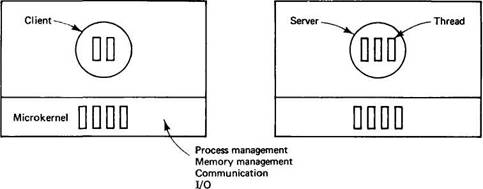Книга: Distributed operating systems
7.1.4. The Amoeba Microkernel
7.1.4. The Amoeba Microkernel
Having looked at the Amoeba hardware model, let us now turn to the software model. Amoeba consists of two basic pieces: a microkernel, which runs on every processor, and a collection of servers that provide most of the traditional operating system functionality. The overall structure is shown in Fig. 7-2.

Fig. 7-2. Amoeba software structure.
The Amoeba microkernel runs on all machines in the system. The same kernel can be used on the pool processors, the terminals (assuming that they are computers, rather than X terminals), and the specialized servers. The microkernel has four primary functions:
1. Manage processes and threads.
2. Provide low-level memory management support.
3. Support communication.
4. Handle low-level I/O.
Let us consider each of these in turn.
Like most operating systems, Amoeba supports the concept of a process. In addition, Amoeba also supports multiple threads of control within a single address space. A process with one thread is essentially the same as a process in UNIX. Such a process has a single address space, a set of registers, a program counter, and a stack.
In contrast, although a process with multiple threads still has a single address space shared by all threads, each thread logically has its own registers, its own program counter, and its own stack. In effect, a collection of threads in a process is similar to a collection of independent processes in UNIX, with the one exception that they all share a single common address space.
A typical use for multiple threads might be in a file server, in which every incoming request is assigned to a separate thread to work on. That thread might begin processing the request, then block waiting for the disk, then continue work. By splitting the server up into multiple threads, each thread can be purely sequential, even if it has to block waiting for I/O. Nevertheless, all the threads can, for example, have access to a single shared software cache. Threads can synchronize using semaphores or mutexes to prevent two threads from accessing the shared cache simultaneously.
The second task of the kernel is to provide low-level memory management. Threads can allocate and deallocate blocks of memory, called segments. These segments can be read and written, and can be mapped into and out of the address space of the process to which the calling thread belongs. A process must have at least one segment, but it may also have many more of them. Segments can be used for text, data, stack, or any other purpose the process desires. The operating system does not enforce any particular pattern on segment usage.
The third job of the kernel is to handle interprocess communication. Two forms of communication are provided: point-to-point communication and group communication. These are closely integrated to make them similar.
Point-to-point communication is based on the model of a client sending a message to a server, then blocking until the server has sent a reply back. This request/reply exchange is the basis on which almost everything else is built.
The other form of communication is group communication. It allows a message to be sent from one source to multiple destinations. Software protocols provide reliable, fault-tolerant group communication to user processes in the presence of lost messages and other errors.
The fourth function of the kernel is to manage low-level I/O. For each I/O device attached to a machine, there is a device driver in the kernel. The driver manages all I/O for the device. Drivers are linked with the kernel and cannot be loaded dynamically.
Device drivers communicate with the rest of the system by the standard request and reply messages. A process, such as a file server, that needs to communicate with the disk driver, sends it request messages and gets back replies. In general, the client does not have to know that it is talking to a driver. As far as it is concerned, it is just communicating with a thread somewhere.
Both the point-to-point message system and the group communication make use of a specialized protocol called FLIP. This protocol is a network layer protocol and has been designed specifically to meet the needs of distributed computing. It deals with both unicasting and multicasting on complex internetworks. It will be discussed later.
- 7.1. INTRODUCTION TO AMOEBA
- 7.1.1. History of Amoeba
- 4.4.4 The Dispatcher
- About the author
- Chapter 7. The state machine
- Appendix E. Other resources and links
- Example NAT machine in theory
- The final stage of our NAT machine
- Compiling the user-land applications
- The conntrack entries
- Untracked connections and the raw table
- Basics of the iptables command




